A Longitudinal Spatial-Temporal Analysis of Ancient Village Tourism Development in Zhejiang, China
Abstract
1. Introduction
2. Literature Review
2.1. Ancient Village Tourism Development in China
2.2. Spatial Analysis in Tourism
3. Research Method
3.1. The Study Context
3.2. Data Sources
3.3. Data Analysis
3.3.1. Average Nearest Neighbor Index
3.3.2. Kernel Density Estimation
3.3.3. Standard Deviational Ellipse
3.3.4. Exploratory Spatial Data Analysis Model (ESDA)
3.3.5. Buffer Analysis
4. Results and Discussion
4.1. Distribution of the Ancient Village Tourist Destinations in 2016, 2018, and 2020
4.1.1. Spatial Distribution Patterns
4.1.2. Spatial Clustering Structure
4.1.3. Overall Evolution Features
4.2. Spatial Correlations of the Ancient Village Tourist Destinations in 2016, 2018, and 2020
4.2.1. Global Autocorrelation Analysis
4.2.2. Local Autocorrelation Analysis
4.3. Contributing Factors to the Spatial Distribution of Ancient Village Tourist Destinations
4.3.1. Relationship between the Ancient Village Tourist Destinations and Transportation
4.3.2. Relationship between Ancient Village Tourist Destinations and the Source Market
4.3.3. Relationship between Ancient Village Tourist Destinations and the Topography
4.3.4. Relationship between the Ancient Village Tourist Destinations and the Economy
5. Implications
5.1. Theoretical Implications
5.2. Practical Implications
6. Limitations, Future Research, and Conclusions
Author Contributions
Funding
Institutional Review Board Statement
Informed Consent Statement
Data Availability Statement
Conflicts of Interest
References
- Liu, C.; Dou, X.; Li, J.; Cai, A. Analyzing government role in rural tourism development: An empirical investigation from China. J. Rural. Stud. 2020, 79, 177–188. [Google Scholar] [CrossRef]
- Lenao, M.; Saarinen, J. Integrated rural tourism as a tool for community tourism development: Exploring culture and heritage projects in the north-East District of Botswana. S. Afr. Geogr. J. 2015, 97, 203–216. [Google Scholar] [CrossRef]
- World Tourism Organization (WTO). World Tourism Leaders Meeting: The Social Impacts of Tourism Final Report; WTO: Madrid, Spain, 1997. [Google Scholar]
- Sims, R. Food, place and authenticity: Local food and the sustainable tourism experience. J. Sustain. Tour. 2009, 3, 321–336. [Google Scholar] [CrossRef]
- Shen, S.; Wang, H.; Quan, Q.; Xu, J. Rurality and rural tourism development in China. Tour. Manag. Perspect. 2019, 30, 98–106. [Google Scholar] [CrossRef]
- Forward Industrial Academy. 2020. Available online: https://new.qq.com/omn/20201204/20201204A046GN00.html (accessed on 15 February 2022).
- Zhongshang Industrial Academy. 2019. Available online: https://www.askci.com/news/chanye/20190313/1615351143157.shtml (accessed on 22 February 2022).
- Hua, Z. Report of China Rural Tourism Development Index. 2016. Available online: http://www.xinhuanet.com/politics/2016-10/29/c_129342435.htm (accessed on 12 March 2022).
- Tao, J.; Wang, Q. Co-evolution: A Model for Renovation of Traditional Villages in the Urban Fringe of Guangzhou, China. J. Asian Archit. Build. Eng. 2014, 3, 555–562. [Google Scholar] [CrossRef]
- Ren, J.; Wu, J. Research on ancient village tourism in China. Anhui Agric. Sci. 2010, 5, 86–91. [Google Scholar]
- Ryan, C.; Huang, S. Tourism in China: Destinations, Planning and Experiences; Channel View Publications: Bristol, UK, 2013. [Google Scholar]
- Ryan, C.; Huang, S. (Eds.) The role of tourism in China’s transitions: An introduction. In Tourism in China: Destinations, Planning and Experiences; Channel View Publications: Bristol, UK, 2013. [Google Scholar]
- Gao, J.; Wu, B.H. Revitalizing traditional villages through rural tourism: A case study of Yuanjia Village, Shaanxi Province, China. Tour. Manag. 2017, 63, 223–233. [Google Scholar] [CrossRef]
- Shao, X.; Liu, Y.; Wang, X.; Zhai, Z.; Li, Z. Tourism responsiveness of traditional villages in the Yellow River Basin. J. Arid. Land Resour. Environ. 2021, 6, 200–208. [Google Scholar]
- Li, Z.X.; Bao, Y.F.; Sun, Z. Spatial distribution characteristics and influencing factors of 3A scenic villages in Zhejiang Province. J. Zhejiang A F Univ. 2019, 6, 1096–1106. [Google Scholar]
- Ketut, L.; Dewi, Y. Modeling the relationships between tourism sustainable factor in the traditional village of Pancasari. Procedia–Soc. Behav. Sci. 2014, 135, 57–63. [Google Scholar]
- Shen, Y.; Liu, Q. The evolution of human-land relationship in the evolution transmutation of rural tourism in traditional villages in suburban cities: A case study of Xunlonghe village. Tour. Trib. 2021, 3, 95–108. [Google Scholar]
- Zhang, X.; Ding, P.; Bao, J. Patron-client ties in tourism: The case study of Xidi, China. Tour. Geogr. 2009, 3, 390–407. [Google Scholar] [CrossRef]
- Guo, Z.; Sun, L. The planning, development and management of tourism: The case of Dangjia, an ancient village in China. Tour. Manag. 2016, 56, 52–62. [Google Scholar] [CrossRef]
- Xu, H.; Dai, S. A system dynamics approach to explore sustainable policies for Xidi, the world heritage village. Curr. Issue Tour. 2012, 5, 441–459. [Google Scholar] [CrossRef]
- Ghaderi, Z. Community capacity building for tourism in a heritage village: The case of Hawraman Takht in Iran. J. Sustain. Tour. 2018, 4, 537–550. [Google Scholar] [CrossRef]
- Kim, S. Tourism impacts continuity of world heritage list inscription and sustainable management of Hahoe Village, Korea: A case study of changes in tourist perception. Sustainability 2019, 10, 2573. [Google Scholar] [CrossRef]
- Kastenhola, E.; Carneiro, M.J.; Marques, C.P.; Lima, J. Understanding and managing the rural tourism experience—The case of a historical village in Portugal. Tour. Manag. Perspect. 2012, 4, 207–214. [Google Scholar] [CrossRef]
- Li, Y.; Liu, H.; Wang, L. Spatial distribution pattern of the catering industry in a tourist city: Taking Lhasa city as a case. J. Resour. Ecol. 2020, 2, 191–205. [Google Scholar]
- Wang, L.; Lu, L.; Tong, S.; Yang, Z.; Wang, Y.; Liang, D. Residents’ attitudes to tourism development in ancient village resorts case study of world cultural heritage of Xidi and Hong villages. Chin. Geogr. Sci. 2004, 1, 70–79. [Google Scholar]
- Zhu, H.; Liu, J.; Wei, Z.; Li, W.; Wang, L.; Liang, D. Residents’ attitude towards sustainable tourism development in a historical-cultural village: Influence of perceived impacts, sense of place and tourism development potential. Sustainability 2017, 1, 61. [Google Scholar] [CrossRef]
- Lee, S.H.; Choi, J.Y.; Yoo, S.H.; Oh, Y.G. Evaluating spatial centrality for integrated tourism management in rural areas GIS and network analysis. Tour. Manag. 2013, 14, 14–24. [Google Scholar] [CrossRef]
- Jackson, J.; Murphy, P. Clusters in regional tourism: An Australian case. Ann. Tour. Res. 2006, 4, 1018–1035. [Google Scholar] [CrossRef]
- Wang, T.; Wang, L.; Ning, Z. Spatial pattern of tourist attractions and its influencing factors in China. J. Spat. Sci. 2018, 2, 327–344. [Google Scholar] [CrossRef]
- Zhang, G.H.; Meng, Y. An Analysis of Characteristics of Spatial Structure of National Rural Tourism Model Counties. J. Ocean. Univ. China 2016, 4, 80–84. [Google Scholar]
- Nepal, S.K. Tourism and rural settlements Nepal’s Annapurna region. Ann. Tour. Res. 2007, 4, 855–875. [Google Scholar] [CrossRef]
- Saxena, G.; Clark, G.; Oliver, T.; Ilbery, B.; Clark, G.; Chabrel, M. Conceptualizing integrated rural tourism. Tour. Geogr. 2007, 4, 347–370. [Google Scholar] [CrossRef]
- Ciolac, R.; Rujescu, C.; Constantinescu, S.; Adamov, T.; Dragoi, M.C.; Lile, R. Management of a Tourist Village Establishment in Mountainous Area through Analysis of Costs and Incomes. Sustainability 2017, 6, 875. [Google Scholar] [CrossRef]
- Nash, R.; Martin, A. Tourism in peripheral areas—The challenges for Northeast Scotland. Tour. Res. 2003, 5, 161–181. [Google Scholar] [CrossRef]
- Flisher, A.; Felsenstein, D. Support for rural tourism: Does it make a difference? Ann. Tour. Res. 2000, 4, 180–194. [Google Scholar]
- Ponce, P.; Aguirre-Padilla, N.; Oliveira, C.; lvarez-García, J.; Río-Rama, M. The spatial externalities of tourism activities in poverty reduction. Sustainability 2020, 12, 6138. [Google Scholar] [CrossRef]
- China Tourism Academy. Development Report of Scenic Spots in China. 2020. Available online: https://www.sohu.com/a/441254476_505583 (accessed on 24 January 2022).
- Sarrión-Gavilán, M.D.; Benítez-Márquez, M.D.; Mora-Rangel, E.O. Spatial distribution of tourism supply in Andalusia. Tour. Manag. Perspect. 2015, 15, 29–45. [Google Scholar] [CrossRef]
- Bhuiyan, M.A.H.; Siwar, C.; Ismail, S.M. Sustainability measurement for ecotourism destination in malaysia: A study on Lake Kenyir, Terengganu. Soc. Indic. Res. 2016, 3, 1029–1045. [Google Scholar] [CrossRef]
- Wei, M. Spatial distribution and the agglomeration performance of high-star hotels. Tour. Anal. 2017, 22, 31–43. [Google Scholar] [CrossRef]
- Jin, X.; Weber, K.; Bauer, T. Impact of clusters on exhibition destination attractiveness: Evidence from Mainland China. Tour. Manag. 2012, 33, 1429–1439. [Google Scholar] [CrossRef]
- Enright, M.J.I. Regional clusters: What we know and what we should know. In Innovation Clusters and Interregional Competition; Bröcker, J., Dohse, D., Soltwedel, R., Eds.; Springer: Berlin/Heidelberg, Germany, 2003. [Google Scholar]
- Dhami, I.; Deng, J. Linking the Recreation Opportunity Spectrum with Travel Spending: A Spatial Analysis in West Virginia. Leis. Sci. 2018, 6, 508–532. [Google Scholar] [CrossRef]
- Huang, C.; Deng, H.; Li, X. Research on spatial structure and influencing factors of rural tourism: A case study of Hubei Province. Sci. Technol. Manag. Land Resour. 2017, 1, 116–125. [Google Scholar]
- Clark, P.J.; Evans, F.C. Distance to Nearest Neighbor as a Measure of Spatial Relationships in Populations. Ecology 1954, 35, 445–453. [Google Scholar] [CrossRef]
- Xu, D.; Huang, Z.; Lv, L.; Chen, X.; Cao, F. Research on Spatial Characteristic of Urban Leisure Tourism Based on POI Mining: A Case Study of Nanjing City. Geogr. Geo-Inf. Sci. 2018, 34, 59–64. [Google Scholar]
- Xie, Z.; Wu, B. Tourism Spatial Structure of Resources-based Attractions in China. Sci. Geogr. Sin. 2008, 28, 748–753. [Google Scholar]
- Janert, P.K. Gnuplot in Action: Understanding Data with Graphs; Tsinghua University Press: Beijing, China, 2012. [Google Scholar]
- Wang, B.; Shi, W.Z.; Miao, Z.L. Confidence Analysis of Standard Deviational Ellipse and Its Extension into Higher Dimensional Euclidean Space. PLoS ONE 2015, 3, 1–17. [Google Scholar] [CrossRef]
- Gutierrez, J.; Garcia-Palomares, J.C.; Romanillos, G.; Salas-Olmedo, M.H. The eruption of Airbnb in tourist cities: Comparing spatial patterns of hotels and peer-to-peer accommodation in Barcelona. Tour. Manag. 2017, 62, 278–291. [Google Scholar] [CrossRef]
- Cliff, A.D.; Ord, J.K. Spatial Processes: Models and Applications; Pion: London, UK, 1981. [Google Scholar]
- Shi, Y.J.; Zhu, Q.; Xu, L.H.; Lu, Z.W.; Wu, Y.Q.; Wang, X.B.; Fei, Y.; Deng, J.Y. Independent or Influential? Spatial-Temporal Features of Coordination Level between Urbanization Quality and Urbanization Scale in China and Its Driving Mechanism. Int. J. Environ. Res. Public Health 2020, 17, 1587. [Google Scholar] [CrossRef] [PubMed]
- Ord, J.K.; Getis, A. Local Spatial Autocorrelation Statistics: Distributional Issues and an Application. Geogr. Anal. 2010, 27, 286–306. [Google Scholar] [CrossRef]
- Wang, T.; Wu, P.; Ge, Q.; Ning, Z. A Ticket prices and revenue levels of tourist attractions in China: Spatial differentiation between prefectural units. Geogr. Anal. 2021, 83, 1–19. [Google Scholar] [CrossRef]
- Luo, H.; Yang, Y. Spatial pattern of hotel distribution in China. Tour. Hosp. Res. 2013, 1, 3–15. [Google Scholar] [CrossRef]
- National Bureau of Statics. Annual Statistics Data for Different Provinces. 2020. Available online: https://data.stats.gov.cn/easyquery.htm?cn=E0103 (accessed on 26 February 2022).
- Wang, X.; Hou, J. Spatial Distribution Features and Influence Factors of Rural Leisure Tourism Destinations in Shandong Province. Sci. Geogr. Sin. 2016, 11, 1706–1714. [Google Scholar]
- Xu, H.; Jiang, F.; Wall, G.; Wang, F. The evolving path of community participation in tourism in China. J. Sustain. Tour. 2019, 8, 1239–1258. [Google Scholar] [CrossRef]
- Megeirhi, H.A.; Woosnam, K.M.; Ribeiro, M.A.; Ramkissoon, H.; Denley, T.J. Employing a value-belief-norm framework to gauge Carthage residents’ intentions to support sustainable cultural heritage tourism. J. Sustain. Tour. 2020, 9, 1351–1370. [Google Scholar] [CrossRef]
- Strzelecka, M.; Boley, B.B.; Strzelecka, C. Empowerment and resident support for tourism in rural Central and Eastern Europe (CEE): The case of Pomerania, Poland. J. Sustain. Tour. 2018, 4, 554–572. [Google Scholar] [CrossRef]
- Sun, F.; Wang, D. The spatial distribution and development pattern of tourism towns and villages with characteristic landscape. Tour. Trib. 2018, 5, 80–93. [Google Scholar]
- Cheng, H.; Hu, W. Spatial structure of class A tourist attraction in Chizhou. Sci. Geogr. Sin. 2014, 10, 1275–1280. [Google Scholar]
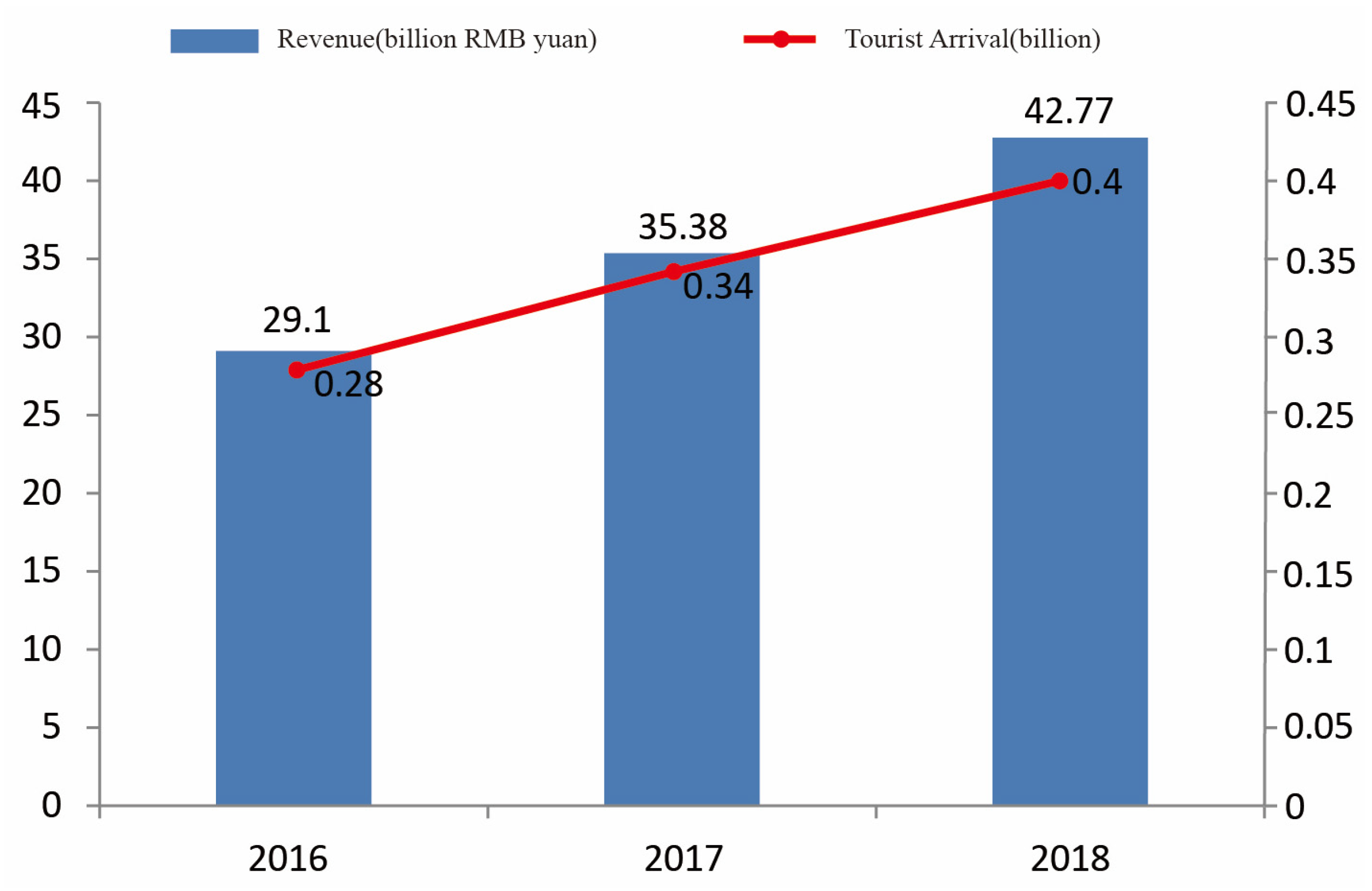
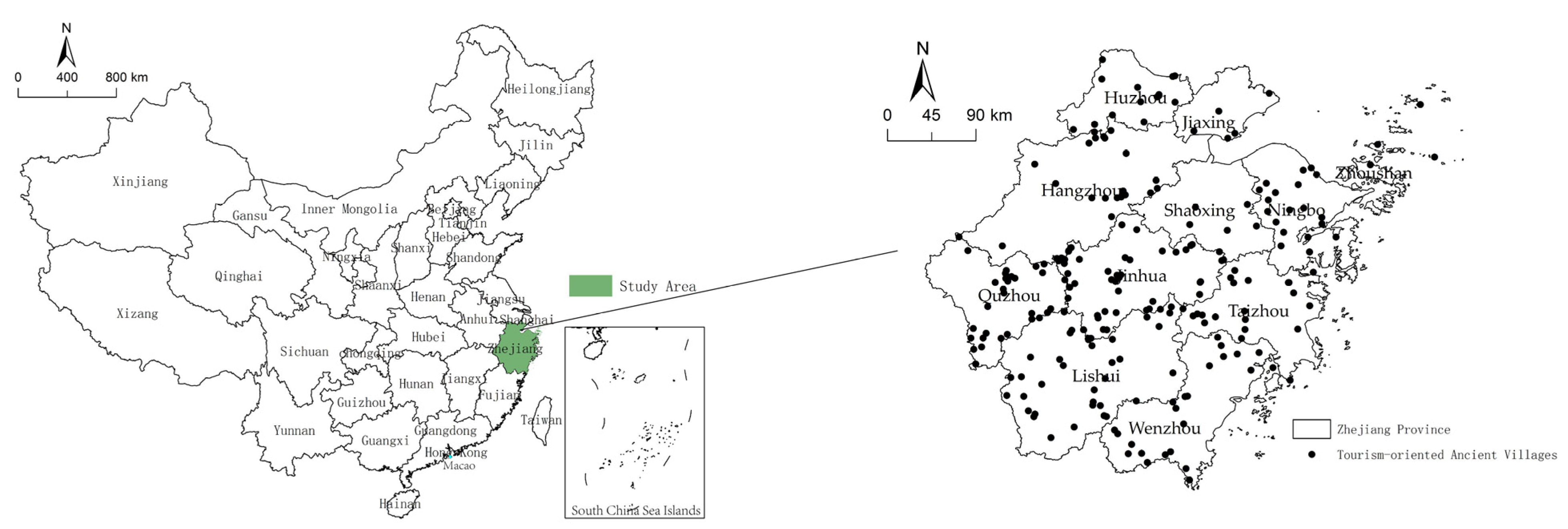
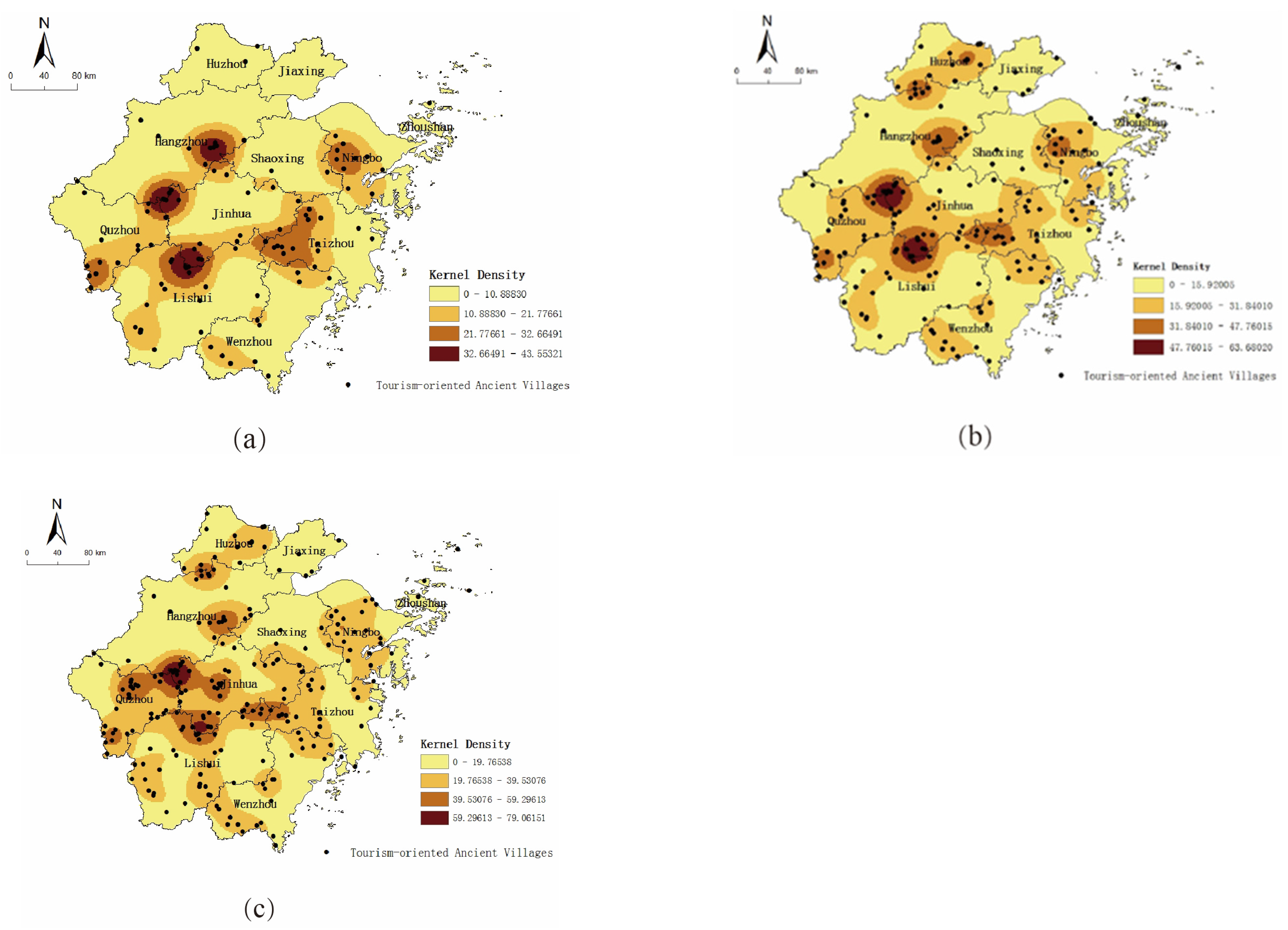

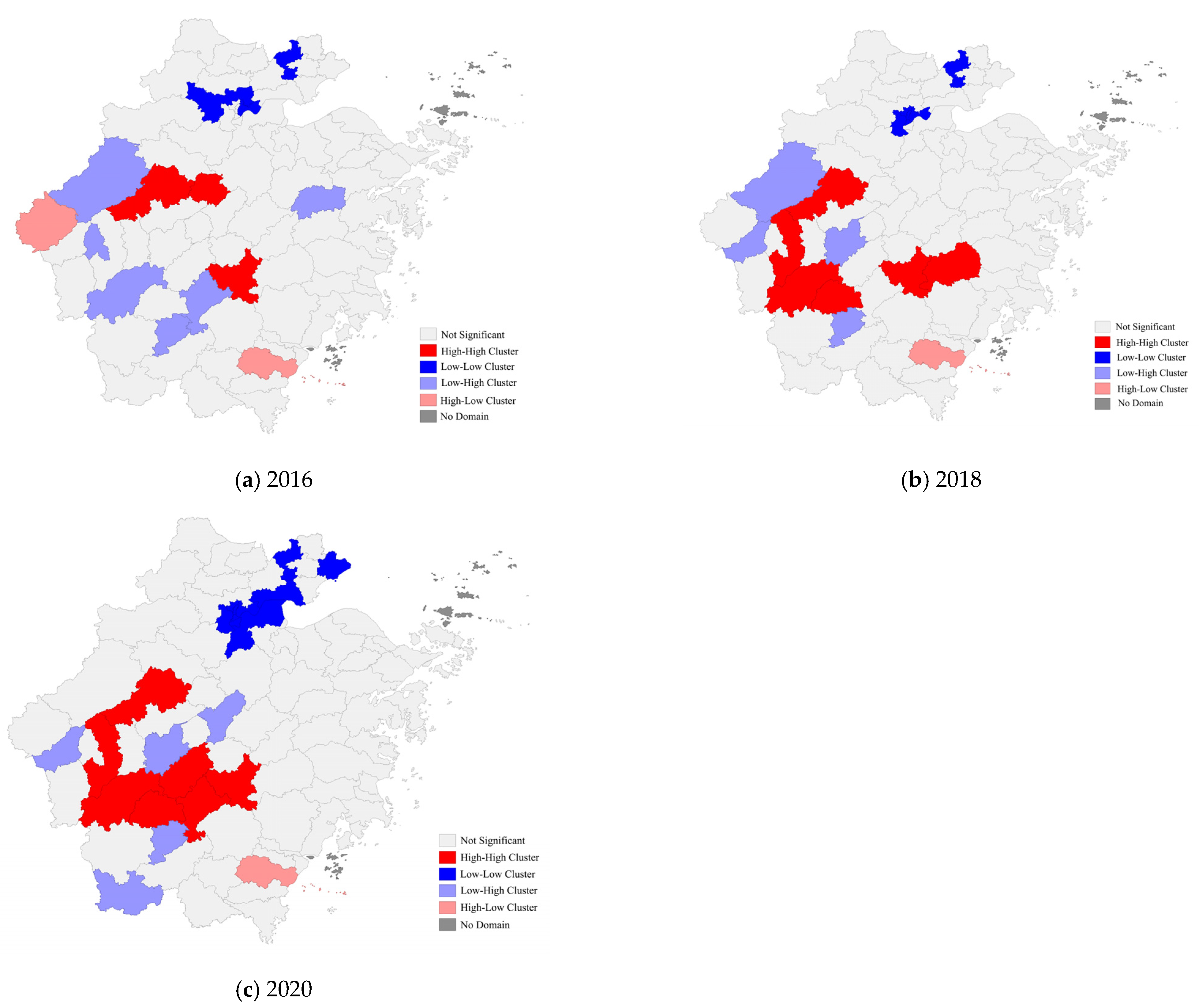


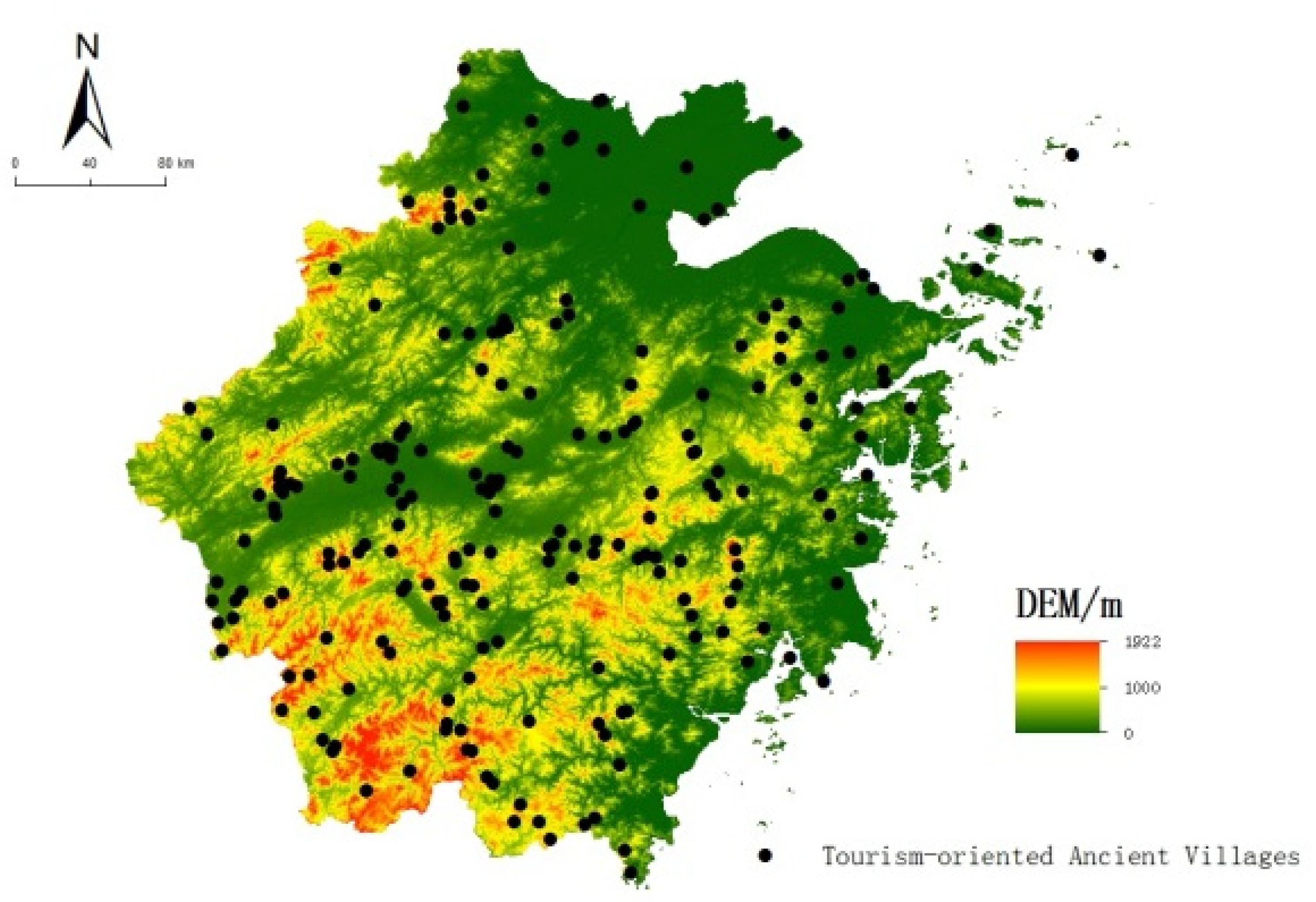
| Cities | 2016 | 2018 | 2020 | ||||||
|---|---|---|---|---|---|---|---|---|---|
| No. of Sample Villages | ANNI | Type | No. of Sample Villages | ANNI | Type | No. of Sample Villages | ANNI | Type | |
| Hangzhou | 14 | 0.80748 | Clustered | 23 | 0.94648 | Clustered | 25 | 0.87918 | Clustered |
| Ningbo | 11 | 1.39911 | Dispersed | 16 | 1.41757 | Dispersed | 20 | 1.36716 | Dispersed |
| Huzhou | 3 | 3.34162 | Dispersed | 13 | 1.33959 | Dispersed | 14 | 1.17316 | Dispersed |
| Jiaxing | 0 | / | / | 5 | 2.43099 | Dispersed | 5 | 2.43099 | Dispersed |
| Zhoushan | 1 | / | / | 3 | 5.05359 | Dispersed | 4 | 2.67768 | Dispersed |
| Shaoxing | 2 | / | / | 5 | 2.54221 | Dispersed | 6 | 2.07905 | Dispersed |
| Jinhua | 16 | 1.03236 | Dispersed | 26 | 0.85812 | Clustered | 39 | 0.66109 | Clustered |
| Quzhou | 16 | 0.85360 | Clustered | 26 | 0.83864 | Clustered | 33 | 0.76443 | Clustered |
| Taizhou | 14 | 1.01486 | Dispersed | 18 | 1.00101 | Dispersed | 21 | 0.93898 | Clustered |
| Wenzhou | 10 | 0.98067 | Clustered | 19 | 1.14035 | Dispersed | 23 | 0.95243 | Clustered |
| Lishui | 19 | 1.08456 | Dispersed | 28 | 1.06636 | Dispersed | 38 | 0.94161 | Clustered |
| Year | Ellipse Area/km² | Center of Gravity Coordinates | Major Axes Standard Deviation/km | Minor Axes Standard Deviation/km | Rotation Angles |
|---|---|---|---|---|---|
| 2016 | 42,996 | 28.9627° N, 119.9732° E | 133.6347 | 102.4199 | 48.3111° |
| 2018 | 49,697 | 29.1385° N, 120.0258° E | 144.8343 | 109.2279 | 33.1232° |
| 2020 | 49,782 | 29.0862° N, 120.0142° E | 144.1777 | 109.9136 | 35.3528° |
| Buffer Range | Number of Sample Villages | Proportion (%) |
|---|---|---|
| 9 km range buffer of the main road | 131 | 57.46% |
| 6 km range buffer of the secondary road | 120 | 52.63% |
| 3 km range buffer of the branch road | 182 | 79.82% |
| Buffer Range | Number of Sample Villages | Proportion (%) |
| 20 km | 24 | 10.52% |
| 40 km | 82 | 35.96% |
| 60 km | 158 | 69.3% |
| DEM Range | Number of Sample Villages | Proportion (%) |
|---|---|---|
| 0~200 m | 109 | 47.81% |
| 200~400 m | 59 | 25.88% |
| 400~600 m | 31 | 13.60% |
| 600~800 m | 20 | 8.77% |
| 800~1000 m | 9 | 3.95% |
Disclaimer/Publisher’s Note: The statements, opinions and data contained in all publications are solely those of the individual author(s) and contributor(s) and not of MDPI and/or the editor(s). MDPI and/or the editor(s) disclaim responsibility for any injury to people or property resulting from any ideas, methods, instructions or products referred to in the content. |
© 2022 by the authors. Licensee MDPI, Basel, Switzerland. This article is an open access article distributed under the terms and conditions of the Creative Commons Attribution (CC BY) license (https://creativecommons.org/licenses/by/4.0/).
Share and Cite
Bao, Y.; Jiang, H.; Ma, E.; Sun, Z.; Xu, L. A Longitudinal Spatial-Temporal Analysis of Ancient Village Tourism Development in Zhejiang, China. Sustainability 2023, 15, 143. https://doi.org/10.3390/su15010143
Bao Y, Jiang H, Ma E, Sun Z, Xu L. A Longitudinal Spatial-Temporal Analysis of Ancient Village Tourism Development in Zhejiang, China. Sustainability. 2023; 15(1):143. https://doi.org/10.3390/su15010143
Chicago/Turabian StyleBao, Yafang, Hanjing Jiang, Emily Ma, Zhi Sun, and Lihua Xu. 2023. "A Longitudinal Spatial-Temporal Analysis of Ancient Village Tourism Development in Zhejiang, China" Sustainability 15, no. 1: 143. https://doi.org/10.3390/su15010143
APA StyleBao, Y., Jiang, H., Ma, E., Sun, Z., & Xu, L. (2023). A Longitudinal Spatial-Temporal Analysis of Ancient Village Tourism Development in Zhejiang, China. Sustainability, 15(1), 143. https://doi.org/10.3390/su15010143






